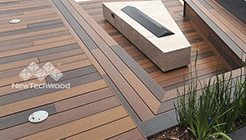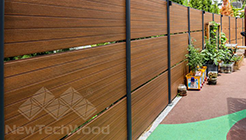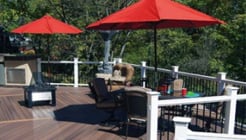In the hands of a modern homeowner, outdoor spaces are often an extension and reflection of a home’s indoor space. Whether picking up on the interior palette, design cues or personal ethos, outdoor rooms have migrated toward materials that are adaptable, versatile and sustainable.
Composite decking checks those boxes, allowing you to create a space that would be at home anywhere from a Cape Cod cottage to a California mid-mod — all while taking fading, scratching, staining, mold and mildew out of the equation.
But what about screws? Can you use deck screws on composite decking? Can you use wood screws on composite decking? Can you screw into composite decking at all?
The Short Answer: It Depends
You can’t use screws to affix a hollow composite deck product. The screws, having less material to grab, will eventually become loose and rise, creating unsightly, uncomfortable and potentially dangerous situations.
If you’re using solid composite decking, screws are an option.There are also options within that option. Along with other options. We’ll take a look at the most common but, first, a few things to consider:
- Nailing is not recommended.
- Because of the density of composite products, installation with screws can be difficult. Pre-drilling is frequently necessary, which adds time and expense to your project.
- If you want a seamless look when using screws, you’ll have to manually hide every screw head (typically by gluing plugs of decking material over the screw heads) — another time and budget burden.
So, about those options…
Wood Screws vs. Composite Screws
First, let’s make sure we’re talking about wood deck screws, not wood screws. Wood deck screws have larger threads (for fast driving and less splitting) and are made of corrosion-resistant materials (typically copper or stainless steel) for outdoor applications. Wood screws have smaller threads and, being mostly steel, are ill-suited for outdoors.
Can you use wood deck screws on composite decking? Yes, but composite screws would be better.
Although composite decking resembles wood and typically contains wood chips and/or fibers, it gets its durability and versatility from the plastic used in its manufacture. Composite deck screws have a tighter grip than wood deck screws because it is needed for the harder, denser composite decking material. They also have smaller heads that countersink more deeply for a cleaner appearance.
Remember: Always use composite decking screws on fascia or stair risers.
However, you might consider eliminating traditional screwing methods altogether.
Composite Decking Clips
Many composite decking boards come with a grooved edge to accommodate hidden fasteners. Thus, boards can be secured from the side rather than by drilling from the top down. The finished look is typically smoother because you eliminate visible screws and the fasteners function as consistent spacers.
Clips don’t require predrilling. They’re also great for accommodating the expansion and contraction that comes with all composite decking (though to a lesser degree than that inherent in wood decking).
Get the Look You Deserve
Composite decks sit on the same basic structure as wood decks. They don’t expand and contract as much as wood. They free you from the amount of maintenance that comes with wood — unless you’re the sort who enjoys annual stripping, staining, power-washing and battling mold and mildew, not to mention concerns over invasive insects such as termites and carpenter ants.
Simply, the right composite deck product, fastened correctly, should deliver years of worry-free outdoor living.
At NewTechWood, we offer a 25-year transferable warranty for our UltraShield composite decking products. If you’re interested in low-maintenance, high-style outdoor living, contact us or fill out our online form.








